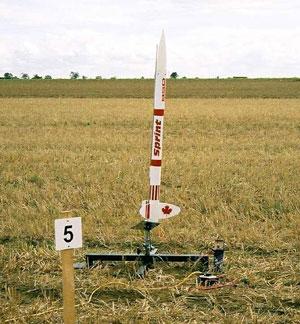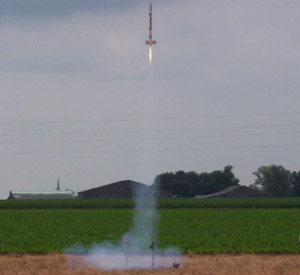BSD High Power Rocketry Canadian Sprint
BSD High Power Rocketry - Canadian Sprint {Kit}
Contributed by Edward Horabin
| Construction Rating: | starstarstarstarstar_border |
| Flight Rating: | starstarstarstarstar |
| Overall Rating: | starstarstarstarstar |
| Manufacturer: | BSD High Power Rocketry  |
 Brief:
Brief:
I bought the Sprint as a relatively cheap, easy to build rocket that could fly
on G motors and could also be used for my UKRA Level 1 flight. Due to the lack
of Aerotech motors in the UK, I needed to have a 38mm motor mount to use the
Pro 38 range of motors. The Canadian Sprint had this as standard and so seemed
the obvious choice. I had heard of the high quality of BSD kits and wasn’t
disappointed when my kit arrived. The kit also came with a 29mm motor adapter
so can also fly on 29mm Aerotech motors.
Construction:
The kit came with:
- one 34" card booster airframe tube
- one 11.25" card payload tube
- one coupler tube
- one 8" motor tube
- three 3/16" plywood elliptical fins
- two plywood centering rings
- one plywood bulkhead plate
- one plastic nose cone
- railbuttons
- motor retention hardware
- motor adapter
- plastic rivets
- a nylon strap
- 10' elastic shock cord
- a 30" parachute
- decals.
All of the parts were of a high quality.
This was the first high power model that I had built and so I took my time and had no real problems. The instructions that came with the kit were very good and included plenty of photos and diagrams which made construction straightforward. 3 hour epoxy was used throughout and produced a very strong model. Chopped fibreglass strands were added to the fin fillets for added strength although this didn’t produce the smoothest of joints. The plastic rivets provided to secure the nosecone to the payload section worked well and look very smart. The kit only came with rail buttons and since I didn’t own a rail, a quarter-inch launch lug was also added. The only other thing I added was a Nomex® heatshield to protect the parachute.
Finishing:
Finishing the rocket was straightforward except for one thing - the line which
was marked the length of the booster for rail button alignment was made with an
ink which reacted with the spraypaint I used. This had the result that however
many coats of primer were applied, the line reappeared after a few minutes as
it removed the pigment from the paint. In the end I sanded off the primer from
the area and removed the line with alcohol. After this there were no further
problems. White primer was followed by Plasti-kote gloss white to give a nice
finish. The vinyl decals supplied with the kit were exceptionally good and
really finish off the rocket. They took a lot of measuring and marking on the
rocket to get them on completely straight but I am very impressed with the end
result.
Construction Rating: 4 out of 5
 Flight:
Flight:
For its maiden flight I chose a Pro 38 G79SS. This motor is very similar to the recommended first motor (an Aerotech G80). The rocket was prepped with some assistance from Mel Sharpe (thanks Mel!) and the motor installed. The supplied motor retention works well - especially if (as suggested in the instructions) a short length of brass tubing is used to keep the retaining clamps horizontal. The rocket launched on a nice column of black smoke and reached an altitude of about 1000 feet. The recovery system worked perfectly - my kit came with an elastic shock cord attached to a nylon strap which is very strong although I may replace it with tubular nylon. The descent rate was just about right and it was recovered with no damage. The second flight was my Level 1 flight at an East Anglian Rocketry Society launch using a Pro 38 H153. The weather was pretty awful - a good breeze was blowing and so I was unsure whether to launch. In the end I went for it and launched from a rail launcher which seemed more stable in the wind. The flight was great except that the rocket drifted a very long way and took nearly two hours to find. Luckily Mike Roberts had his GPS with him and was able to tell us what line it was on. Many thanks to those who helped make that flight successful - various Mikes, the RSO Richard Osborne, the kind person who lent me his pad and those that helped look for the rocket. I also flew the Sprint on an H153 at UKRA 2004 in June which was another great flight to about 1900 feet. The delay was set to 8 seconds and ejection was just before apogee.
Recovery:
The shock cord method seems to work well - after three flights the elastic has suffered no wear and should be good for a few more. Others may prefer tubular nylon but I don't think it is essential on this kit. The rocket descends nicely on the supplied parachute without drifting too far.
Flight Rating: 5 out of 5
Summary:
Overall this is a great kit as an introduction into high power rocketry. It flies perfectly straight, looks great and is really good value for money. The instructions and quality of parts are fantastic. With the lack of Aerotechs in the UK it is a great choice for gaining Level 1 certification. The only problem I had was with the paint compatibility with the ink used on the tubes but this is just a minor quibble. I have since built another BSD kit - a 4 inch diameter Thor although it hasn't flown yet.
Overall Rating: 5 out of 5
Other Reviews
- BSD High Power Rocketry Canadian Sprint By Greg Deeter
Brief: This is BSD's 38mm version of their 3" Sprint. It is called the Canadian Sprint due to it's 38mm motor mount which is perfect for using Cesaroni Pro38 reloads since they are easy to get in Canada. It's a single staged high power rocket that uses parachute recovery. This rocket is named the "Texan Sprint". The name "Sprint" is based on the vintage Estes ...
- BSD High Power Rocketry Canadian Sprint By Ken Bracey
( Contributed - by Ken Bracey - 12/10/01) Brief: The BSD Canadian Sprint is a slightly modified version of the original Sprint rocket. The rocket is a large mid-power rocket that is suitable to go high power and is a great choice for the level one flyer. It has a 38mm motor mount to accept Cessaroni Pro38 motors which are readily available in Canada. A 38 to 29mm motor adapter is ...
 |
 |
Flights
 |
 |
G.D. (October 12, 2004)
Sponsored Ads
 |
 |












Mark Saunders - BSD High Power Rocketry (October 4, 2004)